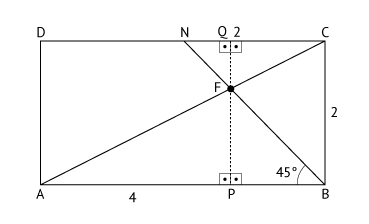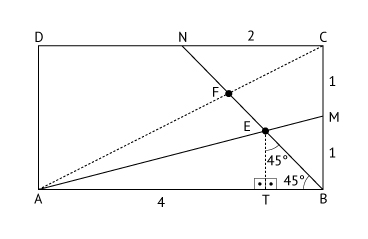Na figura, o retângulo ABCD tem lados de comprimento AB = 4 e BC = 2. Sejam M o ponto médio do lado  e N o ponto médio do lado
e N o ponto médio do lado  . Os segmentos
. Os segmentos  e
e  interceptam o segmento
interceptam o segmento  nos pontos E e F, respectivamente.
nos pontos E e F, respectivamente.

A área do triângulo AEF é igual a
Considere as figuras a seguir:
Figura I:

Figura II:

Na figura I, sendo h = PF, tem-se QF = 2 – h. Como os triângulos AFB e CFN são semelhantes,

Logo, a área do triângulo AFB é dada por:

Considere, agora, a figura II.
Sendo h' = ET, tem-se, do triângulo isósceles ETB, que TB = h'. Ainda, da semelhança dos triângulos AET e AMB: 
Logo,  e, assim, AT = 4h'. Como AT + TB = 4, tem-se 4h' + h' = 4 e, dessa forma,
e, assim, AT = 4h'. Como AT + TB = 4, tem-se 4h' + h' = 4 e, dessa forma,  .
.
Assim, a área do triângulo AEB é dada por:

A área S pedida do triângulo AEF pode ser dada subtraindo-se a área do triângulo AEB da área do triângulo AFB. Logo, a partir de (*) e (**), vem que:





